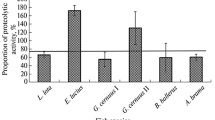Abstract
It has been shown that protease activity increases and amylase activity decreases from the first to the fifth intestinal segment of pike, while lipase and esterase activities vary within fairly narrow limits. The level of proteolytic enzyme activities increases in pikes infected with Triaenophorus nodulosus (Pallas), but the invasion has no effect on amylase, lipase, or esterase activities. The T. nodulosus infection of pike had no substantial influence on glycogen or protein content in the hepatopancreas of fish. However, it was noted that the ratio of protease and amylase activities in the intestines changed toward an increase in the share of proteases and the share of protein in the hepatopancreas of infected fish.
Similar content being viewed by others
References
Davydov, O.N. and Kurovskaya, L.Ya., Parazitokhozyainnye otnosheniya pri tsestodozakh ryb (Host-Parasite Relationships in Fish Cestodosis), Kiev: Naukova Dumka, 1991.
Dobrovol’skii, A.A., Evlanov, I.A., and Shul’man, S.S., Parasitic System: Analysis of Structure and Strategy That Determine Their Stability, in Ekologicheskaya parazitologiya (Ecological Parasitology), Petrozavodsk: Karel. Nauch. Tsentr RAN, 1994, pp. 5–45.
Izvekova, G.I., Physiological Specificity of the Relationship between Triaenorhorus nodulosus (Cestoda) and Its Hosts—Fish, Parazitologiya, 2001, vol. 35, no. 1, pp. 60–68.
Kochetkov, G.A., Prakticheskoe rukovodstvo po enzimologii (A Practical Course in Enzymology), Moscow: Vysshaya Shkola, 1971.
Kuperman, B.I., Lentochnye chervi roda Triaenophorus — parazity ryb (eksperimental’naya sistematika, ekologiya) (Tapeworms of the Genus Triaenorhorus—Fish Parasites (Experimental Systematics and Ecology)), Leningrad: Nauka, 1973.
Kuperman, B.I., Funktsional’naya morfologiya nizshikh tsestod (Functional Morphology of Lower Cestodes), Leningrad: Nauka, 1988.
Kurovskaya, L.Ya., Conjugation of the Digestive Processes in the Bothrioscephalus acheilognathi-Carp System, Parazitologiya, 1991, no. 5, pp. 441–449.
Pronina, S.V. and Pronin, N.M., Vzaimootnosheniya v sistemakh gel’minty — ryby (na tkanevom, organnom i organizmennom urovnyakh) (Relationships in Worm-Fish Systems (Tissue, Organ, and Whole-Body Levels)), Moscow: Nauka, 1988.
Ugolev, A.M. and Kuz’mina, V.V., Pishchevaritel’nye protsessy i adaptatsii u ryb (Digestive Processes and Adaptations in Fish), St. Petersburg: Gidrometeoizdat, 1993.
Alarcón, F.J., Martinez, T.F., Barranco, P., et al., Digestive Proteases during Development of Larvae of Red Palm Weevil, Rhynchophorus errugineus (Olivier, 1790) (Coleoptera: Curculionidae), Insect Biochem. Mol. Biol., 2002, vol. 32, pp. 265–274.
Deguara, S., Jauncey, K., and Agius, C., Enzyme Activities and pH Variations in the Digestive Tract of Gilthead Sea Bream, J. Fish. Biol., 2003, vol. 62, pp. 1033–1043.
Gawlicka, A., Parent, B., Horn, M.H., et al., Activity of Digestive Enzymes in Yolk-Sac Larvae of Atlantic Halibut (Hippoglossus hippoglossus): Indication of Readiness for First Feeding, Aquaculture, 2000, vol. 184, pp. 303–314.
Harpaz, S. and Uni, Z., Activity of Intestinal Mucosal Brush Border Membrane Enzymes in Relation to the Feeding Habits of Three Aquaculture Fish Species, Comp. Biochem. Physiol., 1999, vol. 124A, pp. 155–160.
Izvekova, G.I., Kuperman, B.I., and Kuz’mina, V.V., Digestion and Digestive-Transport Surfaces in Cestodes and Their Fish Hosts, Comp. Biochem. Physiol., 1997, vol. 118 A, no. 4, pp. 1165–1171.
Jónás, E., Ra-gyanszki, M., Oláh, J., and Boross, L., Proteolytic Digestive Enzymes of Carnivorous (Silurus glanis L.), herbivorous (Hypophthalmichthys molitrix Val.) and Omnivorous (Cyprinus carpio L.) Fishes, Aquaculture, 1983, vol. 30, pp. 145–154.
Lundstedt, L.M., Melo, J.F.B., and Moraes, G., Digestive Enzymes and Metabolic Profile of Pseudoplatystoma orruscans (Teleostei: Siluriformes) in Response to Diet Composition, Comp. Biochem. Physiol., 2004, vol. 137 B, pp. 331–339.
Mayberry, L.F., Bristol, J.R., Cajas, O., and Tellez, G., Small Intestinal Sucrase Activity during Experimental Infectious with Nippostrongylus brasiliensis and/or Eimeria nieschulzi in Rats, Z. Parasitenk., 1986, vol. 72, no. 4, pp. 561–564.
Mead, R.W., Histochemical Study on the Distribution of Amylase Activity within the Intestine of the Rat and the Effect of Cestode (Hymenolepis diminuta) Infection, Trans. Amer. Microsc. Soc., 1976, vol. 95, pp. 183–188.
Mead, R.W. and Roberts, L.S., Intestinal Digestion and Absorption of Starch in the Intact Rat: Effects of Cestode (Hymenolepis diminuta) Infection, Comp. Biochem. Physiol., 1972, vol. 41 A, pp. 749–760.
Mettrick, D.F., Hymenolepis diminuta: The Microbiota, Nutritional and Physico-Chemical Gradients in the Small Intestine of Uninfected and Parasitized Rats, Can. J. Physiol. Pharmacol., 1971, vol. 49, pp. 972–984.
Montgomery, R., Determination of Glycogen, Arch. Biochem. Biophys., 1957, vol. 67, pp. 378–386.
Pappas, P.W., Tryptic and Protease Activities in the Normal and Hymenolepis diminuta-Infected Rat Small Intestine, J. Parasit., 1978, vol. 64, pp. 562–564.
Prabhakaran, S.K. and Kamble, S.T., Purification and Characterization of an Esterase Isozyme from Insecticide Resistant and Susceptible Strains of German Cockroach, Blattella germanica (L.), Insect Biochem. Mol. Biol., 1995, vol. 25, pp. 519–524.
Sklan, D., Prag, T., and Lupatsch, I., Structure and Function of the Small Intestine of the Tilapia Oreochromis niloticus and Oreochromis aureus (Teleostei, Cichlidae), Aquaculture Res, 2004, vol. 35, pp. 350–357.
Tengjaroenkul, B., Smith, B.J., Caceci, T., and Smith, S.A., Distribution of Intestinal Enzyme Activities along the Intestinal Tract of Cultured Nile Tilapia, Oreochromis niloticus L., Aquaculture, 2000, vol. 182, pp. 317–327.
Author information
Authors and Affiliations
Corresponding author
Rights and permissions
About this article
Cite this article
Izvekova, G.I., Solovyev, M.M. The activity of digestive enzymes of the pike Esox lucius L. Infected with the cestode Triaenophorus nodulosus (Pallas). Inland Water Biol 5, 113–118 (2012). https://doi.org/10.1134/S1995082911040080
Received:
Published:
Issue Date:
DOI: https://doi.org/10.1134/S1995082911040080




